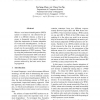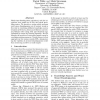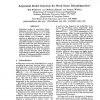184 search results - page 3 / 37 » Learning Expressive Models for Word Sense Disambiguation |
ACL
2007
13 years 9 months ago
2007
When a word sense disambiguation (WSD) system is trained on one domain but applied to a different domain, a drop in accuracy is frequently observed. This highlights the importance...
ACL
1998
13 years 9 months ago
1998
Word sense disambiguation algorithms, with few exceptions, have made use of only one lexical knowledge source. We describe a system which t)erforms word sense disambiguation on al...
NLDB
2007
Springer
14 years 1 months ago
2007
Springer
Word sense disambiguation is the task to identify the intended meaning of an ambiguous word in a certain context, one of the central problems in natural language processing. This p...
CORR
2004
Springer
13 years 7 months ago
2004
Springer
This paper describes the National Research Council (NRC) Word Sense Disambiguation (WSD) system, as applied to the English Lexical Sample (ELS) task in Senseval-3. The NRC system ...
ANLP
1997
13 years 9 months ago
1997
Statistical models of word-sense disambiguation are often based on a small number of contextual features or on a model that is assumed to characterize the interactions among a set...



